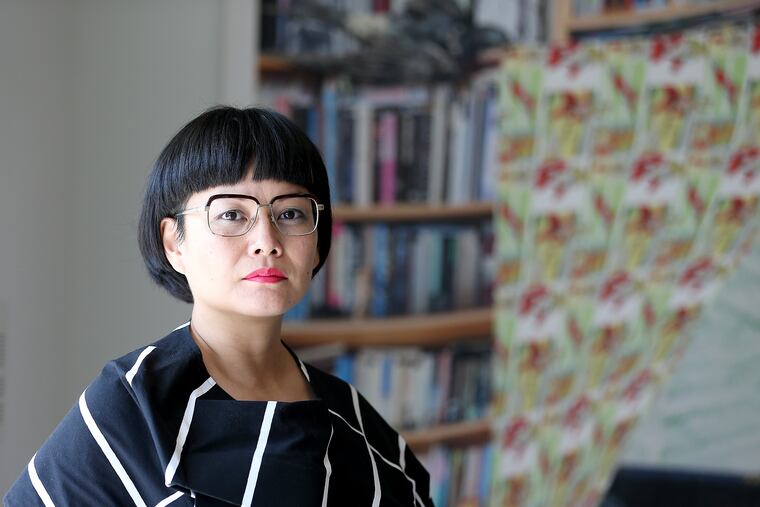From publishing gay manga to running the Asian Arts Initiative, Anne Ishii does it all
Anne Ishii wants the organization to serve the needs of both Chinatown and the city's other growing Asian American communities.

It's not every day that an entrepreneur immersed in the swirling world of gay manga publishing, translation, writing, and marketing becomes head of a major community arts organization in Philadelphia.
But then Anne Ishii, 39, is not your everyday artist or administrator.
Translator of such graphic books as Bat Manga!: The Secret History of Batman in Japan and the Eisner Award-winning My Brother's Husband, Vol. 1, by Gengoroh Tagame, and the cofounder of Massive Goods, a purveyor of gay and feminist art, comics, and fashion by artists from Japan, Ishii has built a kind of renaissance persona within Japanese pop culture in America.
And she has now thrown it all over to become the new executive director of the Asian Arts Initiative, the 25-year-old community arts organization in the 1200 block of Vine Street.
"The grass is always greener on the other side," Ishii said in her office looking out on a blank brick wall just across tiny Pearl Street.
"The free-flowing world of startups and publishing can be as chaotic, isolating, and irresponsible as it is flexible and immediately gratifying. I realize that the world of nonprofit organizations, to say nothing of one with as rich a history and reputation as AAI, would require much more discipline than I might be used to."
That said, AAI is an opportunity, another way to explore collaboration — on a different scale from the loose world of the startup. Arts organizations, particularly in Philadelphia, she argued, have a rich and complex relationship with their communities. This is particularly welcome nowadays, as New York is starting "to feel like it is closing in on itself," becoming a city of "derivatives and speculation" with an oddly monolithic arts culture.
"The cost of living there, the cost of relevance, the cost of everything, is so overwhelming," she said.
Philadelphia, on the other hand, has a rich web of arts organizations that exist within a more varied and nuanced artistic ecosystem.
"I feel that the work I can contribute to the city of Philadelphia may have more practical and human-scale gains," said Ishii, who grew up outside L.A., the daughter of a Japanese father and Korean mother.
"The pull of the city of Philadelphia is definitely in its rich arts organizational culture. I can see that the arts and community organizations here have a profound direct relationship with their constituencies."
>>READ MORE: Gayle Isa is leaving the Asian Arts Initiative, now a force in the future of the city
The Asian Arts Initiative turned 25 this year. It began as a small project under the wing of the Painted Bride Art Center in Old City. Gayle Isa became AAI's first and only executive director until she decided to move on this year.
Ishii took up her new position at the beginning of this month. Isa is a hard act to follow. She turned a little project into a major community player with an annual budget of about $1.5 million. So what's Ishii got cooking?
"We're right on the edge of Chinatown, and the Chinese American population is huge and important, and I absolutely value that relationship," Ishii said. "We also have a rapidly diversifying and growing Asian American populace that identifies as a lot of things that are not necessarily Chinese American and might even not serve that community's interest."
How to simultaneously embrace the older, established community of Chinatown and the proliferating, less visible Asian communities is something of a puzzle, but Ishii plans to find workable solutions.
"I want it all," she said. "I want to address everything."
How to do that?
"I ask myself this question all the time," she said, "and the place I keep coming back to is the fact that we have a physical space and it's huge and we have a lot of art tenants, art groups, and partnerships. So how we effectively use the space is going to be a huge question for me. I want to frame the future of the organization and the vision, my vision, using the physical space that we have and how we are going to be able to utilize it."
That might mean a project to establish a second entrance on Pearl Street that would lead directly into AAI's theater. Such a project would serve not only to focus attention on theater programming, it would further AAI's lengthy efforts to transform Pearl Street from an alley to a vibrant and diverse thoroughfare, a huge project involving many organizations and interests. Ishii is mindful of the complexity.
>> READ MORE: For DesignPhiladelphia, architects re-imagine a forgotten alleyway
Capital and development projects aside, Ishii said she has been struck by the magnitude of AAI's educational and youth programming.
"I want to know how we can engender more art," she said. "It's about creating a place where people can actually learn to prioritize art, to start to consider art's practice."
How to integrate the practice of art into the individual life and ultimately "how we can use art to create community coalitions" is a priority.
"My intention is not to turn the building into a huge art gallery or anything like that," she said. "I'd love for us to continue to use the spaces the way we've been doing, I think pretty successfully. This is to let the artist determine how we use our space. It's a very artist-driven narrative here."
The building is critical to this plan. It is the anchor.
"The fact that we have space is important to me because what I'm hearing from a lot of the artists I've worked with historically is that what they value the most are resources," Ishii said. "I love that."